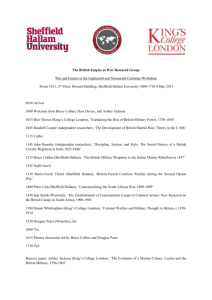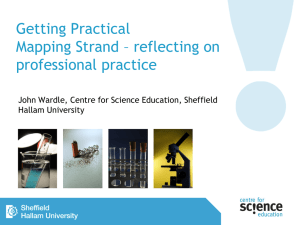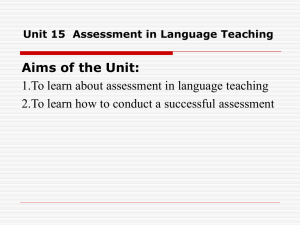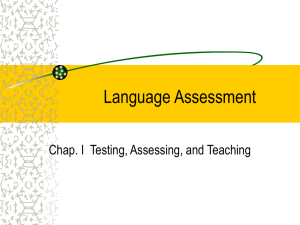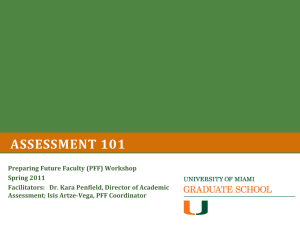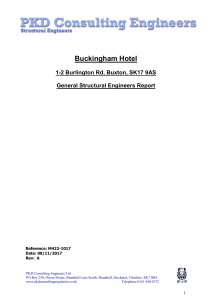Connected assessment - SHU Blogs
advertisement
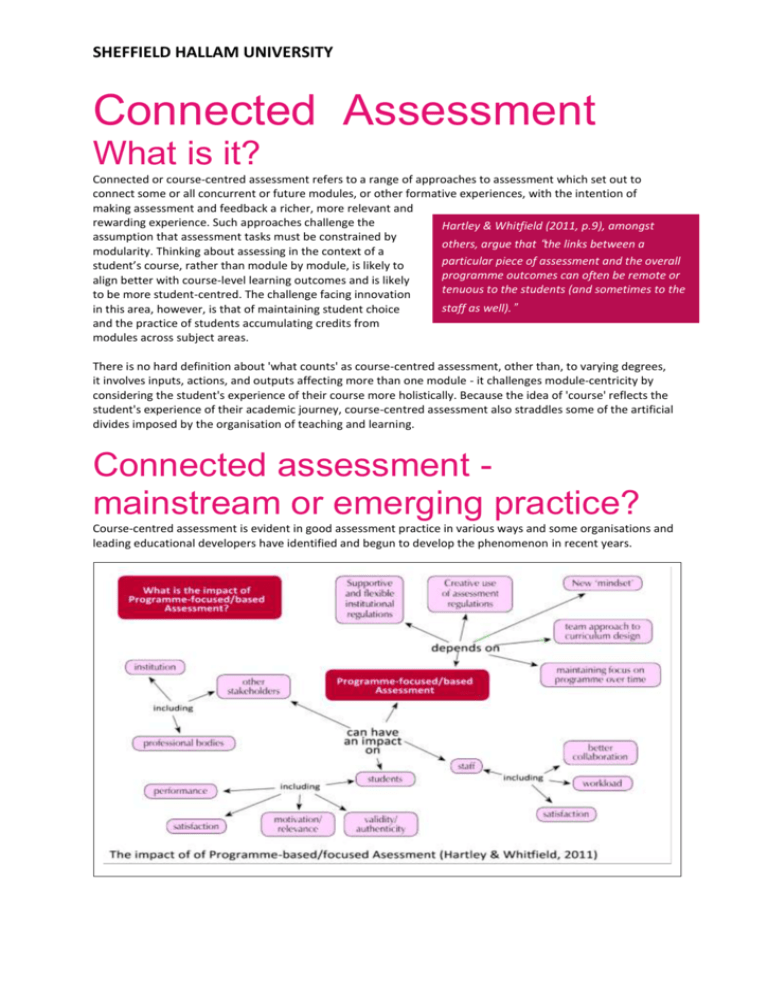
SHEFFIELD HALLAM UNIVERSITY Connected Assessment What is it? Connected or course-centred assessment refers to a range of approaches to assessment which set out to connect some or all concurrent or future modules, or other formative experiences, with the intention of making assessment and feedback a richer, more relevant and rewarding experience. Such approaches challenge the Hartley & Whitfield (2011, p.9), amongst assumption that assessment tasks must be constrained by others, argue that “the links between a modularity. Thinking about assessing in the context of a particular piece of assessment and the overall student’s course, rather than module by module, is likely to programme outcomes can often be remote or align better with course-level learning outcomes and is likely tenuous to the students (and sometimes to the to be more student-centred. The challenge facing innovation staff as well).” in this area, however, is that of maintaining student choice and the practice of students accumulating credits from modules across subject areas. There is no hard definition about 'what counts' as course-centred assessment, other than, to varying degrees, it involves inputs, actions, and outputs affecting more than one module - it challenges module-centricity by considering the student's experience of their course more holistically. Because the idea of 'course' reflects the student's experience of their academic journey, course-centred assessment also straddles some of the artificial divides imposed by the organisation of teaching and learning. Connected assessment mainstream or emerging practice? Course-centred assessment is evident in good assessment practice in various ways and some organisations and leading educational developers have identified and begun to develop the phenomenon in recent years. SHEFFIELD HALLAM UNIVERSITY It comes in different flavours with different names, but whether it is called Programme Level Assessment, Programme-focused Assessment, Integrated Assessment, Course-based Assessment, Synoptic Assessment or Course-Centred Assessment, leading innovators in assessment practice have been developing and promoting the benefits of this approach. In the UK Testa, PASS, ESCAPE, ASKe (see Further Information) are some of the most notable groupings developing this area. McDowell (2012) says "PFA is integrative in nature, assessing the knowledge, understanding and skills that represent key programme aims." She notes that modularity limits the assessment methods available to academics and this contributes to assessment-overload for staff and students. The same limitation affects what can be assessed and this constraint habitually anchors assessment in higher education to knowledge or skill acquisition – a problem, therefore, given the need for higher order higher education learning outcomes. Indeed, Price et al. (2012, p.46) note that, "without such integration, synthesis is largely left up to the student and not assessed." Not everything needs to be assessed and some things can't be assessed in a managed way. However, higher education increasingly finds itself talking about measuring graduate attributes and employability and wanting to value more tacit dimensions of a university education. Similarly Knight & Yorke (2003) highlight the importance of 'slow learning’; that immersed experience of learning in which the learner is 'becoming' developing a new identity by ingesting new ideas, ways of thinking and behaving. Course-centred assessment supports learning outcomes that are extra-modular and inter-modular. It can mean, for example, that the development of academic and learning literacies or attributes can be integrated throughout a course in a meaningful way, avoiding the necessity to offer special literacy or remedial skills modules. Student surveys like the NSS consistently report that assessment and feedback do not deliver what students need. Assessment and feedback need to be designed so they are clearly relevant and useful. It is difficult to achieve this within the confines of a module because a student needs the opportunity to take feedback, reflect on it and apply it. If feedback comes after a task and has no clear follow-on use for the student it is highly likely that they will not value it. Similarly, summative assessment is often removed from the flow of teaching and learning, being perceived by students as something set apart from their formal and informal engagement (Russell & Bygate, 2010). This can promote an instrumental view of the curriculum in which “testing can be reliable, and even valid, and yet measure only the trivial and distorted learning which is an inevitable consequence of the nature of the testing” (Gibbs, 2006). As long as assessment is only perceived to sit within the module paradigm it is inevitably challenging for academics to ensure that it plays its part in supporting the student’s growth and transition through their course, building their self-efficacy and affecting their future performance. Course-centred assessment, if nothing else, creates a context for effective feedback - feedback that is designed to not only inform future engagement, but align students specifically with the opportunities they will have as they progress. Benefits of Course-Centred Assessment Advocates claim benefits for course-centred approaches in terms of resourcing, student retention, lifelong learning, employability, improved student learning, and promoting course coherence (Price et al., 2012). The benefits of adopting a course-based approach will include, Simplification, reducing the assessment burden and assessment bunching; Reducing the tendency for over-assessment (i.e. duplication); Streamlining student engagement in assessment; SHEFFIELD HALLAM UNIVERSITY Better integration patterns for formative and summative assessment; Creating more space for formative engagement, application and synthesis; Addressing fragmented student learning and assessment experiences resulting from modularity; Increased tutor co-operation and discovery of symbiosis in course content; Valuing 'course' authenticity and validity (and Communities of Practice, engagement, co-operation, identity, etc.); Validation of learning in one arena through engagement with another (e.g. application of theory, multi-dimensional projects, etc.). Benefits can include, Supporting progression explicitly (the ‘spiral curriculum’); Creating the opportunity for feed forward to impact on learning and future assessments; Accommodating 'slow learning', learning literacies, employability, attribute development, etc.; Shifting the focus from prosaic student concerns to 'bigger picture' learning; Avoiding a ‘sledgehammer’ tendency of early summative tasks which can damage self-efficacy and progression. Things for Course and Module Leaders to think about The ESCAPE project (Russell & Bygate, 2010) produced visualisation tools that provide an immediate sense of how students experience assessment in their course. What now? - Decide how each task sits within the course and ask "Why does this task take this form at this point in the course?" If you are clear about the task design you will know what summative feedback is needed, and what is not so critical, for each task. Discus your feedback strategy with fellow module leaders so they can look for evidence that feedback is being acted upon. Themes - When designing the course you can take a thematic approach across modules so the student receives feedback that is likely to complement the other formative messages they receive from lecturers on their course. The first half of semester 1 might highlight information literacy for example and this theme can emerge in various ways across the course at that time with formative activities and feedback addressing it too. If all of the work is left to be handled by the assessment task the marking load and quality of the marking will be put under great pressure. SHEFFIELD HALLAM UNIVERSITY Example This example comes from Professor Mike Bramhall (Bramhall et al., 1991; Robinson et al., 1991) and describes the Integrated Assessment approach of the Integrated Engineering Degree which used a multi-disciplinary approach based on a ‘ghost company’ theme and is notable for the linked assignments and the portfolio assessment approached described in the following diagrams. Further examples See the PASS website for further case studies: http://www.pass.brad.ac.uk/case-studies.php References Bramhall, M.D., Eaton, D.E., Robinson, I.M. and Lawson, J.S. (1991). "An Integrated Engineering Degree Programme: Student Centred Learning". In: by R.A.Smith (ed.) "Innovative Teaching in Engineering", Ellis Horwood Ltd (publishers), pp.177-182. Gibbs, G. (2006). "Chapter 2: How assessment frames student learning". In: Bryan C. & Klegg K., eds, Innovative Assessment in Higher Education, Abingdon: Routledge. Hartley, P. and Whitfield, R. (2011). The case for Programme-Focused Assessment. Educational Developments, 12(4), December 2011. Online at: http://www.seda.ac.uk/resources/files/publications_127_Ed%20Devs%2012.4%20 FINAL.pdf Knight, P. T. & Yorke, M. (2003). Assessment, learning and employability. Maidenhead: Open University Press McDowell, L. (2012). Programme Focused Assessment: a short guide. Pass Project. Online at: http://www.pass.brad.ac.uk/short-guide.pdf Price, M., Rust, C., O'Donovan, B., Handley, K. and Bryant, R. (2012). Assessment literacy: the foundation for improving student learning. Oxford: ASKe. Robinson, I.M, Bramhall, M.D, Lawson, J.S. (1991). An Integrated Engineering Degree Programme (IEDP), Australasian Journal of Engineering Education, 2(2). Russell, M. & Bygate , D. (2010). Assessment for Learning: an introduction to the ESCAPE project. Blended Learning in Practice, vol 2010 , no. March , pp. 38-48 .
